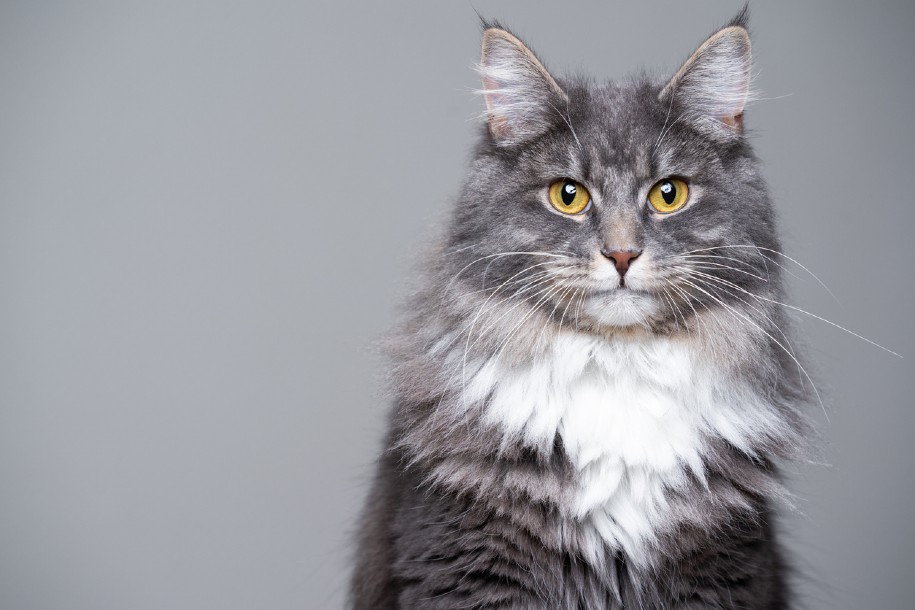Cat Psychology: Things Your Cat Does Explained

- 1 The Tell-Tale Tail
- 2 Tail Straight-Up and Curved at the End
- 3 Puffed, Bottlebrush Tail
- 4 Whipping Tail
- 5 Wrapped Tail
- 6 Slowly Swishing Tail
- 7 Tucked Tail
- 8 The Mystery of the Purr
- 9 Meowing
- 10 Growling, Hissing, and Spitting
- 11 Chirping and Cackling
- 12 Yowling
- 13 The Eyes Have It
- 14 Slow Blinks
- 15 Large, Dilated Pupils
Cats can be confusing animals. Many people claim to dislike cats because they don’t automatically understand their behavior, but having a basic understanding of the reasons cats interact the way they do can totally transform your relationship with them. Unlike dogs, which are generally pretty easy to understand, cats rarely tailor their actions to humans. Instead, we need to learn to understand their mannerisms and act in response. Even when you might believe cats are thinking one thing, their actions might tell a completely different story. Some people incorrectly assume that cats are angry or annoyed when in reality, they just want to play or are hungry. This is just one example of cat psychology and behavior that we need to decode to fully understand and make the most of your relationship with your cat. This might seem like an intimidating task, especially for anyone who is not familiar with feline behavior, but we gathered some expert sources and compiled the best tips for understanding cat psychology. Keep reading for more information on cat psychology and the things your cats do, explained.
The Tell-Tale Tail
You might be quick to disregard your cat’s tail; after all, it might be the last thing you see when your cat enters or leaves a room. However, a cat’s tail is one of the quickest ways to determine how your feline is feeling. Think of the tail as an antenna that directly transmits what your cat is thinking. Learning to decode tail movements and positions is key to understanding any emotions your cat is trying to express. All you need to do is look carefully and interpret the signs below.
Tail Straight-Up and Curved at the End
Some say this looks like an upside-down J or a question mark. Whenever your cat’s tail looks like this, it means she is feeling friendly and is open to being pet or touched. This position often signals a playful mood, so you might consider taking a break to play with your kitty if you see this.
Puffed, Bottlebrush Tail
If your cat’s tail suddenly resembles a bottlebrush, this means your cat is frightened by something and is attempting to make itself bigger to ward off potential predators. Something is startling your cat, so make sure she or the stressor is removed from the environment. Common causes of a puffed tail include dogs or larger animals, vacuum cleaners, or any loud, unexpected noise.
Whipping Tail
A cat whose tail is whipping back and forth quickly is very clearly agitated. Your cat might also do this when scared or intimidated. This is a warning to stay away from your cat and remove any stressors from the environment.
Wrapped Tail
If a cat wraps its tail around your leg or ankles, consider yourself lucky. This behavior is your cat expressing its affection for you and means it is particularly comfortable in your presence.
Slowly Swishing Tail
A tail that is moving back and forth slowly is much different than the rapidly swishing tail described above. This behavior usually indicates that your cat is focused on something, whether than be a toy or loose string. Some cats do this right before pouncing, so take some time to entertain your fluffy friend if you see this behavior.
Tucked Tail
If your cat’s tail is between its legs, something is frightening it into submission. This position signals fear without the possibility of your cat putting up a fight, so check the area to ensure it feels safe.
The Mystery of the Purr
Purring is a behavior most often associated with contentment or comfort. Most cats purr when they are happy and feel safe, but purring can take on different meanings depending on the environment your cat is in, how old it is, and other situational factors. Interestingly, we still don’t know exactly where in a cat’s body purring originates from, but scientists have been able to determine its meaning in different situations. From day one, kittens purr as a signal that they are born in good health, similar to how newborn humans cry after entering the world.Some animal behaviorists have found that cats occasionally purr in stressful situations as a soothing mechanism, similar to how humans might hum or fidget when under duress. Frightened cats might purr in a confrontation with another cat to indicate its submission and unwillingness to fight. Despite these many different reasons for the same behavior, cats most often purr when they are content or feel safe. Pay attention to any changes in your cat’s environment if they purr during odd times.
Meowing
Contrary to popular belief, cats generally only meow when attempting to communicate with humans, not other animals. Studies have shown that cats recognize meowing as a behavior to get the attention of humans, so the next time your cat tries to talk to you, make sure you listen.
Growling, Hissing, and Spitting
Any of these aggressive behaviors are a clear signal to leave your cat alone. Cats who are annoyed or angry might hiss and growl to ward off any threats or annoyances. Don’t be alarmed if your cat growls or hisses when you attempt to pet it; it simply may need to space or time to itself as we all do.
Chirping and Cackling
These funny noises can mean a few different things and provide some insight into what your cat is thinking. Mother cats use chirping noises to tell their kittens to follow or come to them. If your cat has ever seen a bird outside a window in your home, you may have noticed it making chirping or cackling noises at it. This usually indicates excitement and interest in an object, like a bird or squirrel; just make sure that your cat is secured, otherwise it may get a snack for itself. Overall, chirping and cackling noises indicate positive feelings and generally mean that your cat is excited or intrigued about something.
Yowling
You will know a yowl when you hear it. These usually sound like long, drawn-out meows and are quote loud. Cats generally yowl when experiencing distress or when they are in pain. Sometimes, older cats or those with cognitive disorders like dementia will yowl at night or when they are unable to find their owner. Yowls generally indicate some form of distress, and the pitch and volume of the yowl are main indicators of why your cat is upset. Louder, higher pitched yowls indicate higher levels of distress, while lower, quieter yowls indicate confusion or lower levels of distress. Yowls usually indicate negative feelings in your cat, so be sure to pay attention to these signals.
The Eyes Have It
Your cat’s eyes can provide some key indicators of how they are feeling. Knowing how to understand the psychology behind why your cat’s eyes look the way they do can explain a lot about their behavior and the things your cat does. Below are a few different cat eye expressions that indicate different feelings in your cat.
Slow Blinks
When a cat blinks at you slowly, consider it a hug or kiss. This is one of the highest forms of flattery when it comes to cats. To reciprocate the feeling and show your cat that you love it too, blink slowly in return while making direct eye contact.
Large, Dilated Pupils
When your cat’s eyes are dilated, it generally indicates excitement or surprise. Look out for this expression when playing with your cat.
At first glance, cats might not be as straightforward as other animals when it comes to their behavior. Having a basic understanding of cat psychology can help you to foster a healthy relationship with any cat you meet, whether it be yours or someone else’s. Understanding how cats think might take a bit more effort than interpreting dogs’ actions, but it will pay off in the end with your newfound relationship with your feline friend.
